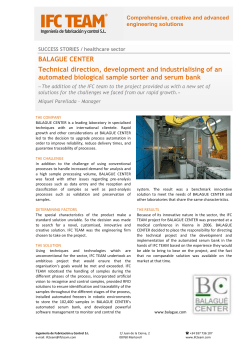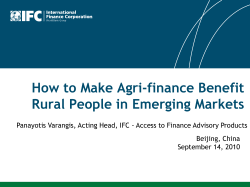
Optimizing World Bank Group Resources and Supporting
Optimizing World Bank Group Resources and Supporting Infrastructure Financing1 At their meeting in February 2014, G20 Ministers of Finance and Central Bank Governors requested the World Bank Group (WBG) to provide a report outlining efforts to optimize its balance sheets to enhance lending capacity, including for infrastructure investment. We look forward to work being coordinated by the WBG to assess the mutual benefits and feasibility of MDB exposure exchanges as a means to optimize lending portfolios.” They also sought ways of supporting global growth by “enhancing the catalytic role of multilateral development banks”, particularly with respect to infrastructure investment. This note responds to that request. Optimising World Bank Group Balance Sheets World Bank Group Governors at their Annual Meetings in October 2013 called upon the WBG to “pursue a finance work program that envisages lifting the growth trend of revenues, resetting expenditures to a leaner cost base by improving organizational and operational efficiency, and better mobilizing internal and external resources to enhance the WBG’s capacity to deliver more development assistance while paying due attention to risk.” Following Governors’ guidance, the Executive Board approved in February the following measures as part of efforts to reshape the WBG’s financial sustainability framework, in order to enhance the IBRD’s revenues and capacity.: Increasing IBRD’s Single Borrower Limit (SBL) by $2.5 billion for Brazil, China, Indonesia, India, and Mexico, with a 50 basis point (bp) surcharge on the incremental amount. Revising IBRD’s minimum equity-to-loan ratio downward from 23 percent to 20 percent, reflecting improvements in portfolio credit risk, enabling more efficient utilization of shareholder capital while remaining financially prudent. Changing IBRD’s loans terms (effective July 1, 2014), restoring the 25bp commitment fee charged on undisbursed balances, and offering longer maturities with increased maturity differentiation. Combined with the anticipated cost savings resulting from the WBG expenditure review exercise currently underway, these measures will enable IBRD to nearly double its annual lending capacity to middle income countries (including for infrastructure financing) from $15 billion to as much as $28 billion per year. This means that the World Bank’s lending capacity—or the amount of loans we can carry on our balance sheet—will increase by $100 billion in the next decade, to roughly $300 billion. The increased capacity strengthens the Bank’s ability to fulfill its countercyclical role in the event of crises. Extension of the maximum loan maturities will strengthen borrower choices with respect to funding infrastructure projects. The WBG is also pursuing additional avenues to expand the envelope of assistance to clients beyond what is possible through traditional channels of development finance by focusing on financial innovation and mobilization of available and underutilized resources. In this regard, the Board recently approved a MIGA/IBRD exposure exchange agreement. This innovative 1 Prepared by World Bank Group staff for the meeting of G20 Ministers of Finance and Central Bank Governors, April 2014, Washington, DC. 1 approach to managing exposure concentration will provide both MIGA and IBRD with a new risk management tool that will allow them to free up capacity to support additional business. The first exchange will be of an IBRD exposure to Brazil for a MIGA exposure to Panama, under a MIGA contract for non-honoring of sovereign financial obligations. Both Panama and Brazil will see benefits, as IBRD and MIGA will have more headroom to do additional business in each country. Efforts with Regional Development Banks With our regional development bank partners, we are exploring the feasibility and possible mutual benefit of permitting exposure exchanges between MDBs, as a way towards mitigating concentration risk. Exposure exchanges have the potential to permit more efficient use of existing capital. IBRD is leading an MDB-wide Working Group, with participation from the AfDB, AsDB, EBRD, EIB and IaDB, to develop this idea. The Working Group is currently assessing different options and confronting several technical challenges for a potential framework for exchanging exposure among MDBs when there is a mutual benefit. Increasing Leverage at the International Finance Corporation In 2009, IFC created a wholly-owned subsidiary, IFC Asset Management Company (AMC), to raise and manage third-party capital. AMC-managed funds invest in IFC transactions, thereby leveraging IFC's balance sheet and development impact. To date AMC has raised $6.3 billion in six funds, with capital commitments coming from sovereign wealth funds, government pension funds, private pension funds, bilateral DFIs and governments, and other multilaterals. The most recent of these funds is the IFC Global Infrastructure Fund, which has raised $1.2 billion from sovereign and institutional investors to make equity and quasi-equity investments in infrastructure projects in developing countries. It funded its first investment in November 2013. Assuming typical capital structures at the project level, this fund aims to support about $18 billion in infrastructure investment over the next five years, at the same time making good riskadjusted returns for its investors. AMC is in the process of raising similar funds for specific regions that will invest in infrastructure as well as other sectors. These are actively managed funds with dedicated AMC fund teams owing a fiduciary duty to the fund investors. IFC has also developed a new approach to leveraging its lending operations through a co-financing arrangement that is both innovative and replicable. Given growing demand for long-term financing, particularly for infrastructure, IFC, through its new Managed Co-Lending Portfolio Program (MCPP), has developed a platform to broaden its investor base to specifically target non-bank financial investors. IFC launched this new product in November 2013 with $3 billion of funding from China and is prepared to replicate such partnership with other countries. MCPP is a syndications platform that allows IFC to aggregate and manage, on behalf of investors, a series of co-investments across IFC’s future loan portfolio. IFC lends for its own account and makes co-investments in these loans through MCPP. IFC and MCPP loans are structured with the same terms and conditions and IFC supervises each loan treating the MCPP investment equally with its own. In this way the MCPP portfolio mimics IFC’s own loan book ensuring IFC and the Investor have aligned interests and the same investment returns. 2 For investors, MCPP provides access to a unique and diversified investment portfolio. By leveraging IFC’s existing capacity and creating a product that pools loans (thereby allowing investment at scale), it also creates a cost efficient mechanism for investors to access the loan market. For emerging market borrowers it creates an additional source of long term financing helping to accelerate the project development process. For IFC, MCPP Investment directly leverages its own capital at risk in a single project and thus allows IFC to efficiently scale investments and optimize its own balance sheet. There is considerable headroom within IFC to deploy investment from other institutions to further leverage IFC’s loan platform. MCPP Investments can be structured across the entire loan book or can be customized to meet investor preferences, for example, IDA, infrastructure, or climate-smart projects. The platform also complements existing IFC Syndications products which are targeted at commercial banks and IFIs and which have mobilized more than $45bn since 1957. Mobilizing Resources for Infrastructure Investment: the Global Infrastructure Facility Last year, the WBG indicated that it was designing of a new mechanism (a global infrastructure facility) to mobilize resources and leverage them more effectively to support infrastructure investment in emerging markets and developing economies (EMDEs), including by strengthening the supporting policy and regulatory environment and project quality.2 Since that time, we have been working to ensure that the mechanism represents genuine additionality and can serve as an innovative model for resource mobilization and infrastructure financing in an environment of increasingly constrained official sector sources of financing. The approach underpinning the proposal for a Global Infrastructure Facility (GIF) reflects an evolution in the WBG’s thinking based on extensive consultations with public and private partners over since last year. We are taking a holistic, catalytic and inclusive approach that reflects several factors: 1. With decreased fiscal space and significant demands on government budgets, the public sector alone cannot be expected to finance the significant (and growing) infrastructure needs. 2. Private-sector investors with appropriately long-term investment horizons report a shortage of financially-viable infrastructure projects in which to invest. 3. With limited public and private resources, it is essential that governments increase the impact on job creation, growth and development of the scarce resources allocated to infrastructure. This, rather than merely increasing the amount we spend on infrastructure, is critical. Against this backdrop, the WBG is working on an integrated platform that brings together upstream and downstream support for infrastructure, one that seeks to make better use of scarce WBG resources to leverage additional financing for infrastructure, and more actively seeks partnerships with other multilateral and national development banks. Responding to the Challenge of Mobilizing Long-Term Financing for Infrastructure Investment: A Note to the G20 Study Group on Long-Term Investment Financing ,July 2013 3 In terms of upstream support, the GIF would be an institutional focal point for integrated technical and advisory assistance to infrastructure development in order to assist clients with regulatory and institutional strengthening, market reform, and in the selection and preparation of projects that have potential to become financially viable. This part of the GIF platform would draw on: (i) WBG expertise and on-the-ground presence to assist clients in addressing weaknesses in their underlying investment climate that hold back external participation in infrastructure; and (ii) technical and advisory support and WBG standards and safeguards to improve infrastructure project selection, design and preparation. The objective is to reduce the overall riskiness of infrastructure investments in EMDEs thereby making them more financially attractive to external investors. In terms of downstream support, helping to increase the attractiveness of projects to investment partners with different needs and levels of risk appetite, the GIF, working with other financial and development partners, would help achieve the scale and terms needed to make projects bankable. The GIF will seek to leverage scarce resources to attract financing from the public/official sectors (including other multilateral development banks, national development banks, donors, development finance institutions, sovereign wealth funds) and the private sector. Using a combination of private and public finance sources, the GIF could utilize, at different stages of project development and implementation, various tools (partial guarantees, risk sharing facilities) and financing structures. This would involve use of the WBG’s credit enhancement instruments and own resources, in the appropriate budget and financial framework. But the focus will be on leveraging and arranging other sources of public and private sector financing. To this, we the WBG’s ability to help bring together financial partners in both the public and private sectors – including regional and national development banks, institutional investors and the private sector—through expertise in structuring complex deals and by making more strategic use of catalytic financing and WBG risk sharing instruments. Over time, the hope is to help promote and create a stock of infrastructure assets in emerging markets and developing economies that can provide the basis for the emergence of a new asset class attractive to longerterm investors. The governance of the GIF remains under discussion but will reflect an appropriate balance between the need to allow financial partners to provide guidance to the platform, the importance of protecting the WBG from reputational risk and the criticality of ensuring the technical independence and credibility of GIF upstream activities as a means to lowering the overall level of risk to potential external investors in GIF-supported infrastructure projects. Next Steps on the Global Infrastructure Facility The proposal is for the GIF to be launched as a pilot and be housed in the WBG as a small unit that coordinates and works across all relevant WBG global practice groups (GPs). For all infrastructure projects meeting the pre-defined eligibility criteria agreed by the WBG and its GIF partners, the relevant GPs will be responsible for the project implementation. The GIF will aim to overcome existing constraints to developing and financing priority infrastructure in client countries by helping to integrate technical, advisory and financial support from across 4 multilateral development banks (MDBs), with the goal of enhancing the mobilization of resources from official and private sources. It is expected that partner organizations (including other multilateral development banks) could use the platform to more effectively crowd source financing and risk mitigation instruments to implement infrastructure projects which are not being implemented today due to size or complexity or both. The core principles of the GIF include: Focus on leveraging of solutions that bring in private-sector participation—project design financing modalities will bring together comparative advantages of public and private sectors; Addressing public goods—investments to focus on core infrastructure, with initial emphasis on projects that are climate friendly and/or trade enabling; Openness and Partnering for solutions—mobilizing resources and collaboration between WBG and private, public and multilateral development partners, including regional development banks; Sustainability—use of World Bank Group social and environmental standards and safeguards; Holistic view of infrastructure development—upstream to downstream support; and Investment Asset Class – using a group of potentially financially viable projects that incorporate common standards, contribute, over time, to the creation of a new asset class for long term investors like pension funds. 5
© Copyright 2025

















